Entrepreneurship and Small Business Management: Venture, Types
VerifiedAdded on 2020/06/04
|17
|5194
|28
Report
AI Summary
This report provides a comprehensive overview of entrepreneurship and small business management, exploring the relationship between different types of entrepreneurship and ventures, including small-scale, large-scale, scalable, and social enterprises. It highlights the impact of micro and small businesses on the economy, emphasizing their role in employment, innovation, and contribution to local economies. The report also examines the characteristics of successful entrepreneurs and the factors that influence their motivation and mindset, concluding with the importance of leveraging personal background and past experiences to enhance entrepreneurial endeavors. The document is available on Desklib, a platform offering a variety of study tools for students.

Entrepreneurship and Small
Business Management
Business Management
Paraphrase This Document
Need a fresh take? Get an instant paraphrase of this document with our AI Paraphraser
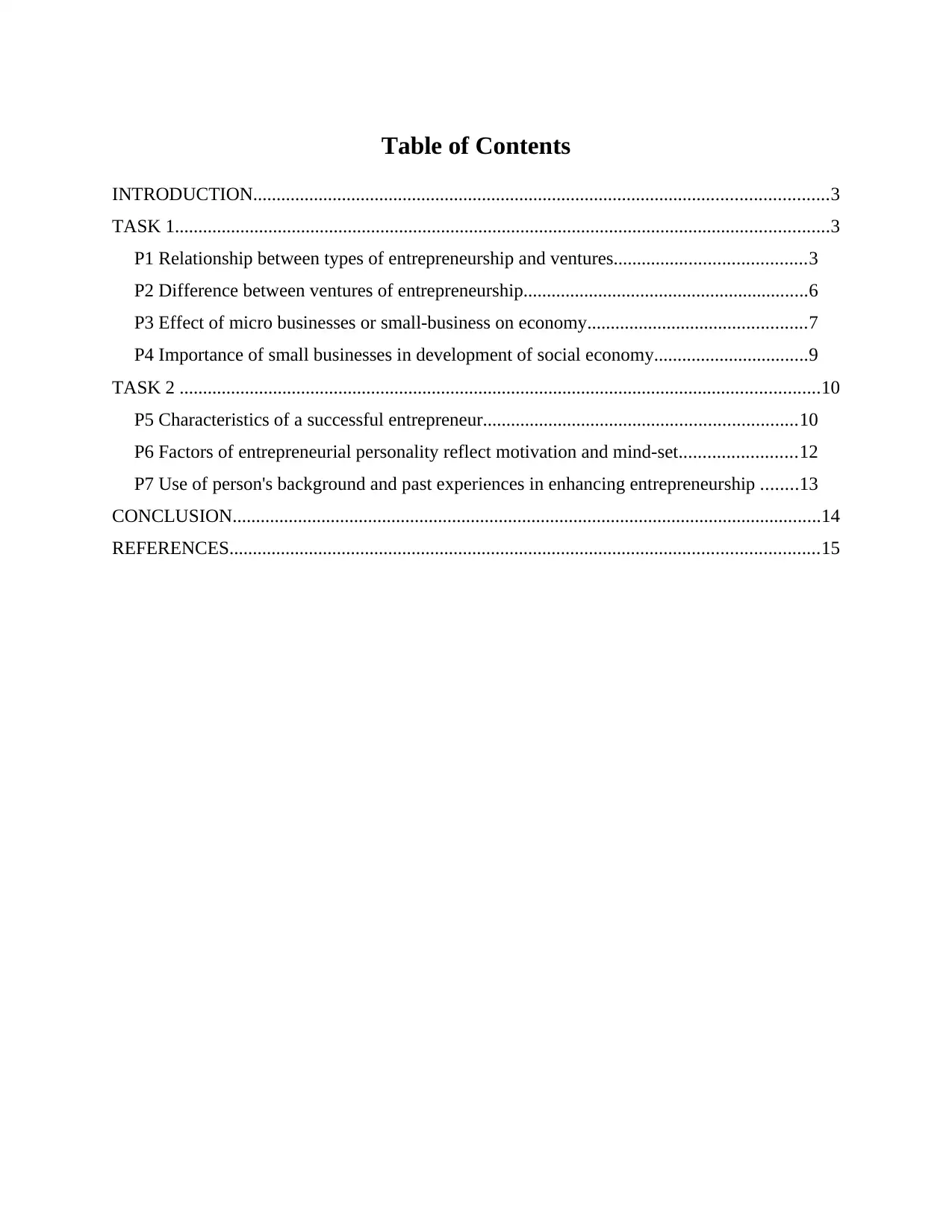
Table of Contents
INTRODUCTION...........................................................................................................................3
TASK 1............................................................................................................................................3
P1 Relationship between types of entrepreneurship and ventures.........................................3
P2 Difference between ventures of entrepreneurship.............................................................6
P3 Effect of micro businesses or small-business on economy...............................................7
P4 Importance of small businesses in development of social economy.................................9
TASK 2 .........................................................................................................................................10
P5 Characteristics of a successful entrepreneur...................................................................10
P6 Factors of entrepreneurial personality reflect motivation and mind-set.........................12
P7 Use of person's background and past experiences in enhancing entrepreneurship ........13
CONCLUSION..............................................................................................................................14
REFERENCES..............................................................................................................................15
INTRODUCTION...........................................................................................................................3
TASK 1............................................................................................................................................3
P1 Relationship between types of entrepreneurship and ventures.........................................3
P2 Difference between ventures of entrepreneurship.............................................................6
P3 Effect of micro businesses or small-business on economy...............................................7
P4 Importance of small businesses in development of social economy.................................9
TASK 2 .........................................................................................................................................10
P5 Characteristics of a successful entrepreneur...................................................................10
P6 Factors of entrepreneurial personality reflect motivation and mind-set.........................12
P7 Use of person's background and past experiences in enhancing entrepreneurship ........13
CONCLUSION..............................................................................................................................14
REFERENCES..............................................................................................................................15

⊘ This is a preview!⊘
Do you want full access?
Subscribe today to unlock all pages.

Trusted by 1+ million students worldwide
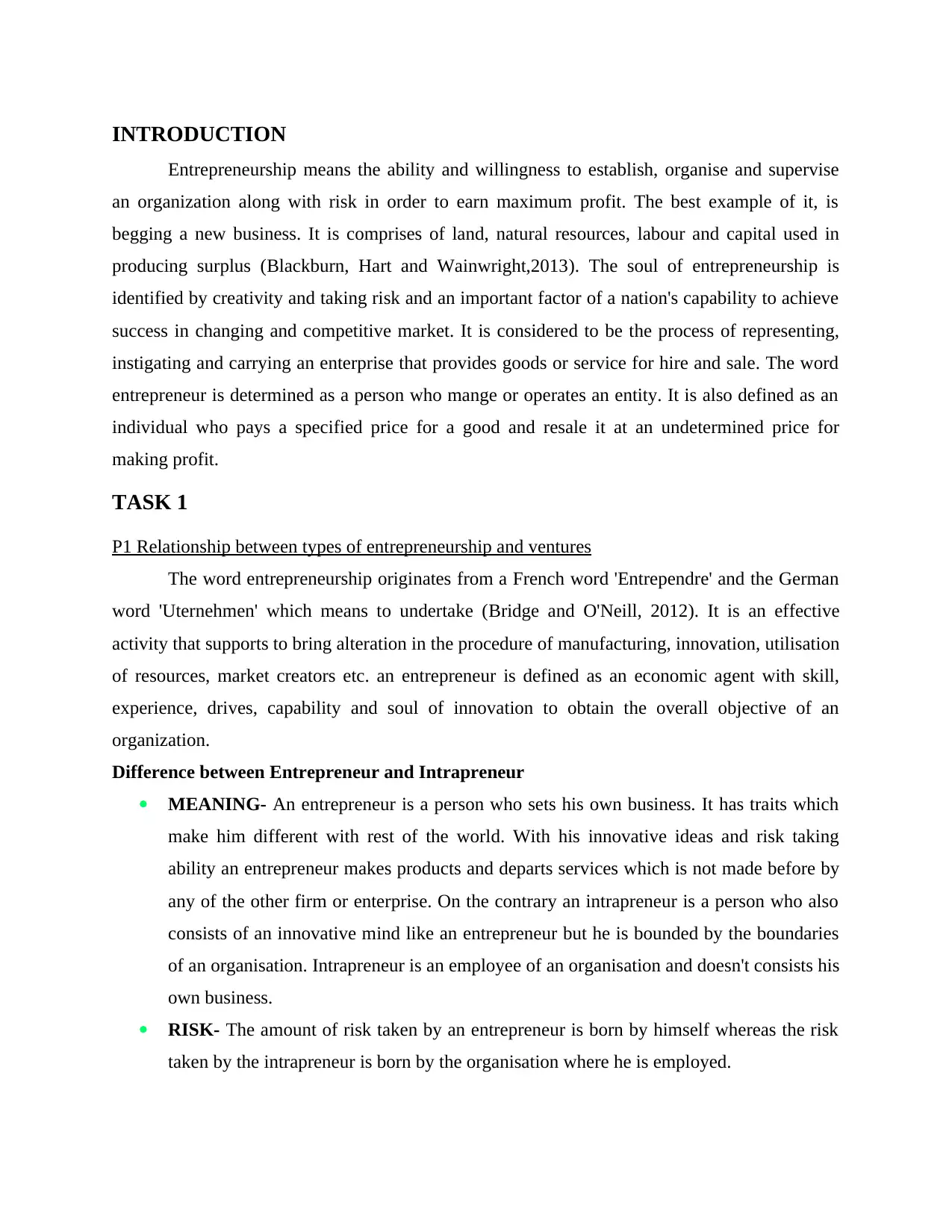
INTRODUCTION
Entrepreneurship means the ability and willingness to establish, organise and supervise
an organization along with risk in order to earn maximum profit. The best example of it, is
begging a new business. It is comprises of land, natural resources, labour and capital used in
producing surplus (Blackburn, Hart and Wainwright,2013). The soul of entrepreneurship is
identified by creativity and taking risk and an important factor of a nation's capability to achieve
success in changing and competitive market. It is considered to be the process of representing,
instigating and carrying an enterprise that provides goods or service for hire and sale. The word
entrepreneur is determined as a person who mange or operates an entity. It is also defined as an
individual who pays a specified price for a good and resale it at an undetermined price for
making profit.
TASK 1
P1 Relationship between types of entrepreneurship and ventures
The word entrepreneurship originates from a French word 'Entrependre' and the German
word 'Uternehmen' which means to undertake (Bridge and O'Neill, 2012). It is an effective
activity that supports to bring alteration in the procedure of manufacturing, innovation, utilisation
of resources, market creators etc. an entrepreneur is defined as an economic agent with skill,
experience, drives, capability and soul of innovation to obtain the overall objective of an
organization.
Difference between Entrepreneur and Intrapreneur
MEANING- An entrepreneur is a person who sets his own business. It has traits which
make him different with rest of the world. With his innovative ideas and risk taking
ability an entrepreneur makes products and departs services which is not made before by
any of the other firm or enterprise. On the contrary an intrapreneur is a person who also
consists of an innovative mind like an entrepreneur but he is bounded by the boundaries
of an organisation. Intrapreneur is an employee of an organisation and doesn't consists his
own business.
RISK- The amount of risk taken by an entrepreneur is born by himself whereas the risk
taken by the intrapreneur is born by the organisation where he is employed.
Entrepreneurship means the ability and willingness to establish, organise and supervise
an organization along with risk in order to earn maximum profit. The best example of it, is
begging a new business. It is comprises of land, natural resources, labour and capital used in
producing surplus (Blackburn, Hart and Wainwright,2013). The soul of entrepreneurship is
identified by creativity and taking risk and an important factor of a nation's capability to achieve
success in changing and competitive market. It is considered to be the process of representing,
instigating and carrying an enterprise that provides goods or service for hire and sale. The word
entrepreneur is determined as a person who mange or operates an entity. It is also defined as an
individual who pays a specified price for a good and resale it at an undetermined price for
making profit.
TASK 1
P1 Relationship between types of entrepreneurship and ventures
The word entrepreneurship originates from a French word 'Entrependre' and the German
word 'Uternehmen' which means to undertake (Bridge and O'Neill, 2012). It is an effective
activity that supports to bring alteration in the procedure of manufacturing, innovation, utilisation
of resources, market creators etc. an entrepreneur is defined as an economic agent with skill,
experience, drives, capability and soul of innovation to obtain the overall objective of an
organization.
Difference between Entrepreneur and Intrapreneur
MEANING- An entrepreneur is a person who sets his own business. It has traits which
make him different with rest of the world. With his innovative ideas and risk taking
ability an entrepreneur makes products and departs services which is not made before by
any of the other firm or enterprise. On the contrary an intrapreneur is a person who also
consists of an innovative mind like an entrepreneur but he is bounded by the boundaries
of an organisation. Intrapreneur is an employee of an organisation and doesn't consists his
own business.
RISK- The amount of risk taken by an entrepreneur is born by himself whereas the risk
taken by the intrapreneur is born by the organisation where he is employed.
Paraphrase This Document
Need a fresh take? Get an instant paraphrase of this document with our AI Paraphraser
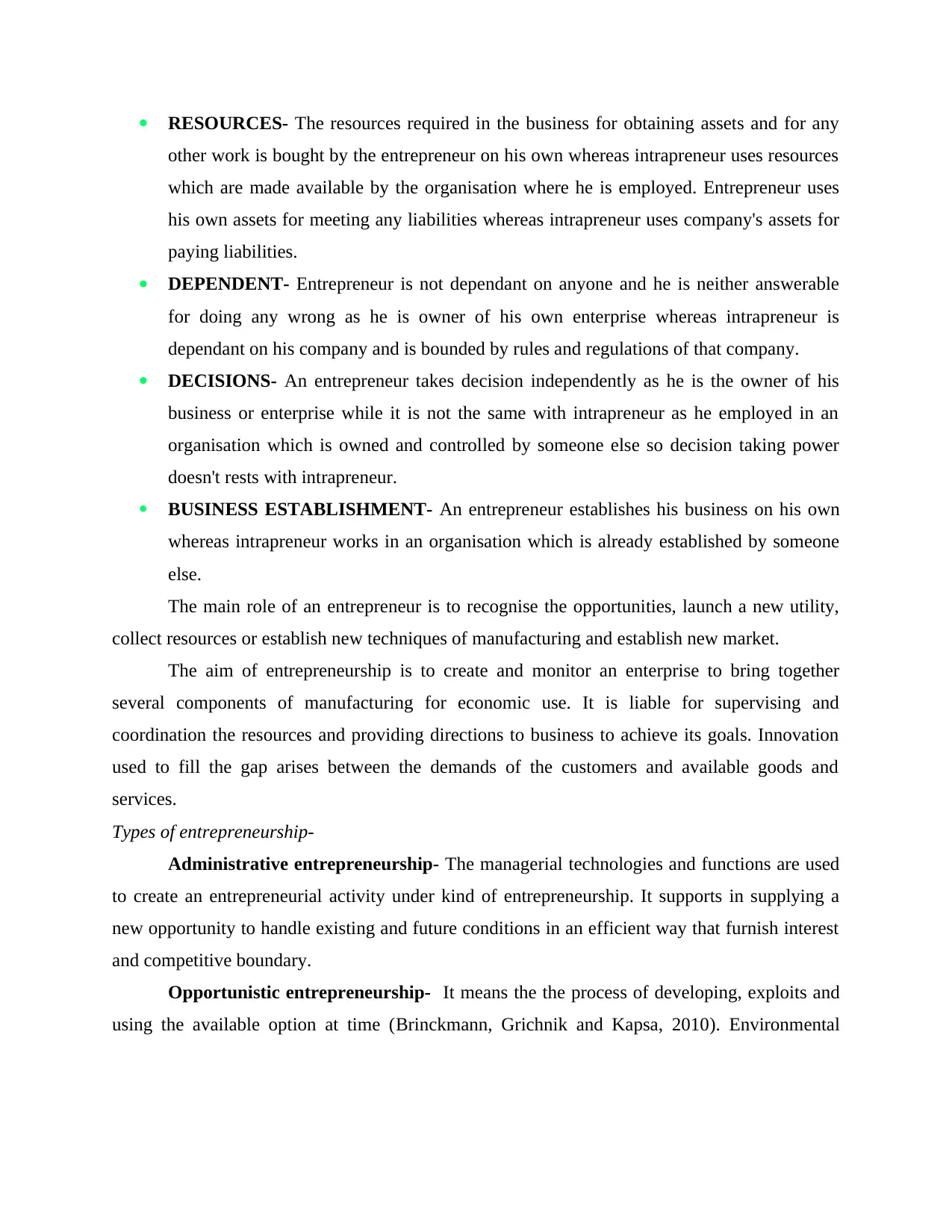
RESOURCES- The resources required in the business for obtaining assets and for any
other work is bought by the entrepreneur on his own whereas intrapreneur uses resources
which are made available by the organisation where he is employed. Entrepreneur uses
his own assets for meeting any liabilities whereas intrapreneur uses company's assets for
paying liabilities.
DEPENDENT- Entrepreneur is not dependant on anyone and he is neither answerable
for doing any wrong as he is owner of his own enterprise whereas intrapreneur is
dependant on his company and is bounded by rules and regulations of that company.
DECISIONS- An entrepreneur takes decision independently as he is the owner of his
business or enterprise while it is not the same with intrapreneur as he employed in an
organisation which is owned and controlled by someone else so decision taking power
doesn't rests with intrapreneur.
BUSINESS ESTABLISHMENT- An entrepreneur establishes his business on his own
whereas intrapreneur works in an organisation which is already established by someone
else.
The main role of an entrepreneur is to recognise the opportunities, launch a new utility,
collect resources or establish new techniques of manufacturing and establish new market.
The aim of entrepreneurship is to create and monitor an enterprise to bring together
several components of manufacturing for economic use. It is liable for supervising and
coordination the resources and providing directions to business to achieve its goals. Innovation
used to fill the gap arises between the demands of the customers and available goods and
services.
Types of entrepreneurship-
Administrative entrepreneurship- The managerial technologies and functions are used
to create an entrepreneurial activity under kind of entrepreneurship. It supports in supplying a
new opportunity to handle existing and future conditions in an efficient way that furnish interest
and competitive boundary.
Opportunistic entrepreneurship- It means the the process of developing, exploits and
using the available option at time (Brinckmann, Grichnik and Kapsa, 2010). Environmental
other work is bought by the entrepreneur on his own whereas intrapreneur uses resources
which are made available by the organisation where he is employed. Entrepreneur uses
his own assets for meeting any liabilities whereas intrapreneur uses company's assets for
paying liabilities.
DEPENDENT- Entrepreneur is not dependant on anyone and he is neither answerable
for doing any wrong as he is owner of his own enterprise whereas intrapreneur is
dependant on his company and is bounded by rules and regulations of that company.
DECISIONS- An entrepreneur takes decision independently as he is the owner of his
business or enterprise while it is not the same with intrapreneur as he employed in an
organisation which is owned and controlled by someone else so decision taking power
doesn't rests with intrapreneur.
BUSINESS ESTABLISHMENT- An entrepreneur establishes his business on his own
whereas intrapreneur works in an organisation which is already established by someone
else.
The main role of an entrepreneur is to recognise the opportunities, launch a new utility,
collect resources or establish new techniques of manufacturing and establish new market.
The aim of entrepreneurship is to create and monitor an enterprise to bring together
several components of manufacturing for economic use. It is liable for supervising and
coordination the resources and providing directions to business to achieve its goals. Innovation
used to fill the gap arises between the demands of the customers and available goods and
services.
Types of entrepreneurship-
Administrative entrepreneurship- The managerial technologies and functions are used
to create an entrepreneurial activity under kind of entrepreneurship. It supports in supplying a
new opportunity to handle existing and future conditions in an efficient way that furnish interest
and competitive boundary.
Opportunistic entrepreneurship- It means the the process of developing, exploits and
using the available option at time (Brinckmann, Grichnik and Kapsa, 2010). Environmental
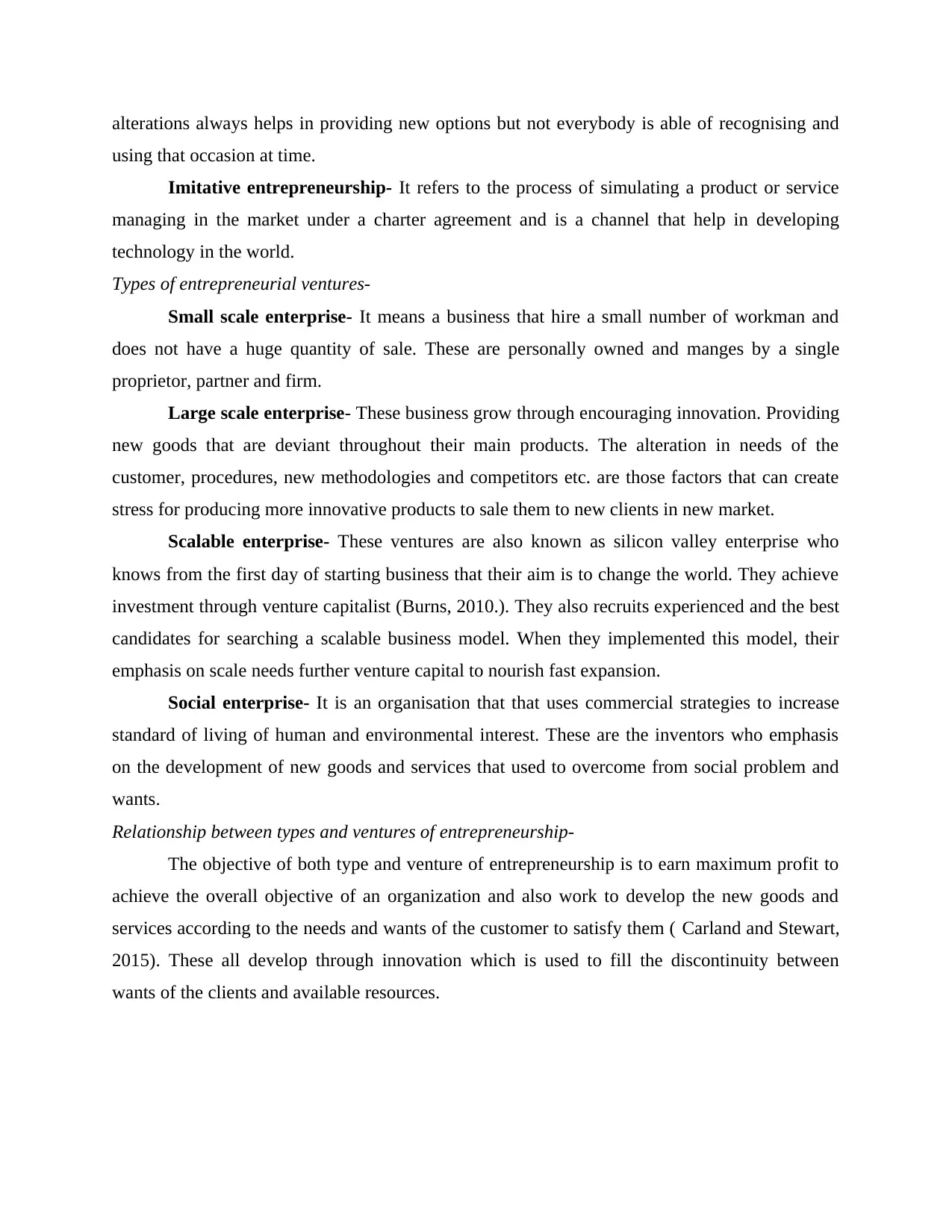
alterations always helps in providing new options but not everybody is able of recognising and
using that occasion at time.
Imitative entrepreneurship- It refers to the process of simulating a product or service
managing in the market under a charter agreement and is a channel that help in developing
technology in the world.
Types of entrepreneurial ventures-
Small scale enterprise- It means a business that hire a small number of workman and
does not have a huge quantity of sale. These are personally owned and manges by a single
proprietor, partner and firm.
Large scale enterprise- These business grow through encouraging innovation. Providing
new goods that are deviant throughout their main products. The alteration in needs of the
customer, procedures, new methodologies and competitors etc. are those factors that can create
stress for producing more innovative products to sale them to new clients in new market.
Scalable enterprise- These ventures are also known as silicon valley enterprise who
knows from the first day of starting business that their aim is to change the world. They achieve
investment through venture capitalist (Burns, 2010.). They also recruits experienced and the best
candidates for searching a scalable business model. When they implemented this model, their
emphasis on scale needs further venture capital to nourish fast expansion.
Social enterprise- It is an organisation that that uses commercial strategies to increase
standard of living of human and environmental interest. These are the inventors who emphasis
on the development of new goods and services that used to overcome from social problem and
wants.
Relationship between types and ventures of entrepreneurship-
The objective of both type and venture of entrepreneurship is to earn maximum profit to
achieve the overall objective of an organization and also work to develop the new goods and
services according to the needs and wants of the customer to satisfy them ( Carland and Stewart,
2015). These all develop through innovation which is used to fill the discontinuity between
wants of the clients and available resources.
using that occasion at time.
Imitative entrepreneurship- It refers to the process of simulating a product or service
managing in the market under a charter agreement and is a channel that help in developing
technology in the world.
Types of entrepreneurial ventures-
Small scale enterprise- It means a business that hire a small number of workman and
does not have a huge quantity of sale. These are personally owned and manges by a single
proprietor, partner and firm.
Large scale enterprise- These business grow through encouraging innovation. Providing
new goods that are deviant throughout their main products. The alteration in needs of the
customer, procedures, new methodologies and competitors etc. are those factors that can create
stress for producing more innovative products to sale them to new clients in new market.
Scalable enterprise- These ventures are also known as silicon valley enterprise who
knows from the first day of starting business that their aim is to change the world. They achieve
investment through venture capitalist (Burns, 2010.). They also recruits experienced and the best
candidates for searching a scalable business model. When they implemented this model, their
emphasis on scale needs further venture capital to nourish fast expansion.
Social enterprise- It is an organisation that that uses commercial strategies to increase
standard of living of human and environmental interest. These are the inventors who emphasis
on the development of new goods and services that used to overcome from social problem and
wants.
Relationship between types and ventures of entrepreneurship-
The objective of both type and venture of entrepreneurship is to earn maximum profit to
achieve the overall objective of an organization and also work to develop the new goods and
services according to the needs and wants of the customer to satisfy them ( Carland and Stewart,
2015). These all develop through innovation which is used to fill the discontinuity between
wants of the clients and available resources.
⊘ This is a preview!⊘
Do you want full access?
Subscribe today to unlock all pages.

Trusted by 1+ million students worldwide
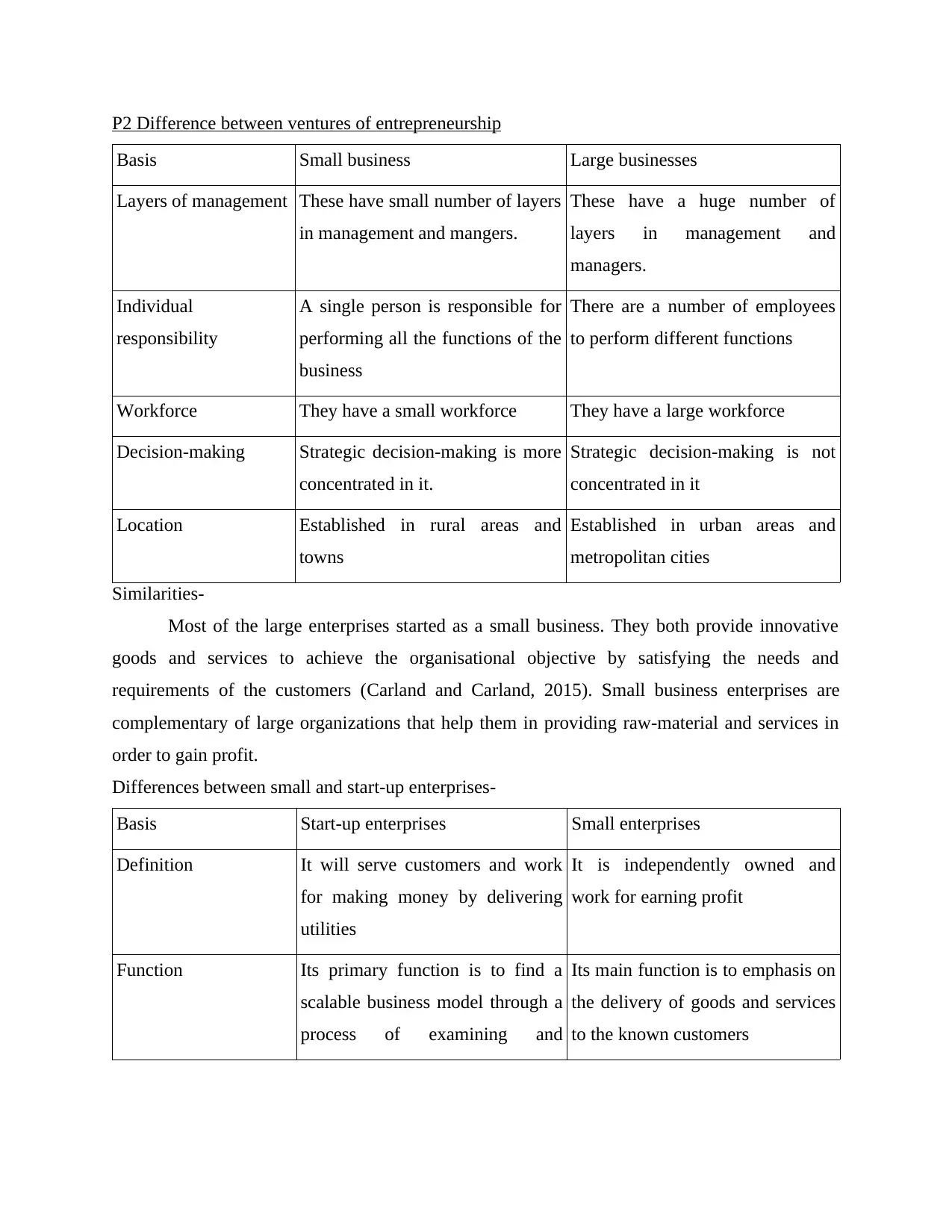
P2 Difference between ventures of entrepreneurship
Basis Small business Large businesses
Layers of management These have small number of layers
in management and mangers.
These have a huge number of
layers in management and
managers.
Individual
responsibility
A single person is responsible for
performing all the functions of the
business
There are a number of employees
to perform different functions
Workforce They have a small workforce They have a large workforce
Decision-making Strategic decision-making is more
concentrated in it.
Strategic decision-making is not
concentrated in it
Location Established in rural areas and
towns
Established in urban areas and
metropolitan cities
Similarities-
Most of the large enterprises started as a small business. They both provide innovative
goods and services to achieve the organisational objective by satisfying the needs and
requirements of the customers (Carland and Carland, 2015). Small business enterprises are
complementary of large organizations that help them in providing raw-material and services in
order to gain profit.
Differences between small and start-up enterprises-
Basis Start-up enterprises Small enterprises
Definition It will serve customers and work
for making money by delivering
utilities
It is independently owned and
work for earning profit
Function Its primary function is to find a
scalable business model through a
process of examining and
Its main function is to emphasis on
the delivery of goods and services
to the known customers
Basis Small business Large businesses
Layers of management These have small number of layers
in management and mangers.
These have a huge number of
layers in management and
managers.
Individual
responsibility
A single person is responsible for
performing all the functions of the
business
There are a number of employees
to perform different functions
Workforce They have a small workforce They have a large workforce
Decision-making Strategic decision-making is more
concentrated in it.
Strategic decision-making is not
concentrated in it
Location Established in rural areas and
towns
Established in urban areas and
metropolitan cities
Similarities-
Most of the large enterprises started as a small business. They both provide innovative
goods and services to achieve the organisational objective by satisfying the needs and
requirements of the customers (Carland and Carland, 2015). Small business enterprises are
complementary of large organizations that help them in providing raw-material and services in
order to gain profit.
Differences between small and start-up enterprises-
Basis Start-up enterprises Small enterprises
Definition It will serve customers and work
for making money by delivering
utilities
It is independently owned and
work for earning profit
Function Its primary function is to find a
scalable business model through a
process of examining and
Its main function is to emphasis on
the delivery of goods and services
to the known customers
Paraphrase This Document
Need a fresh take? Get an instant paraphrase of this document with our AI Paraphraser
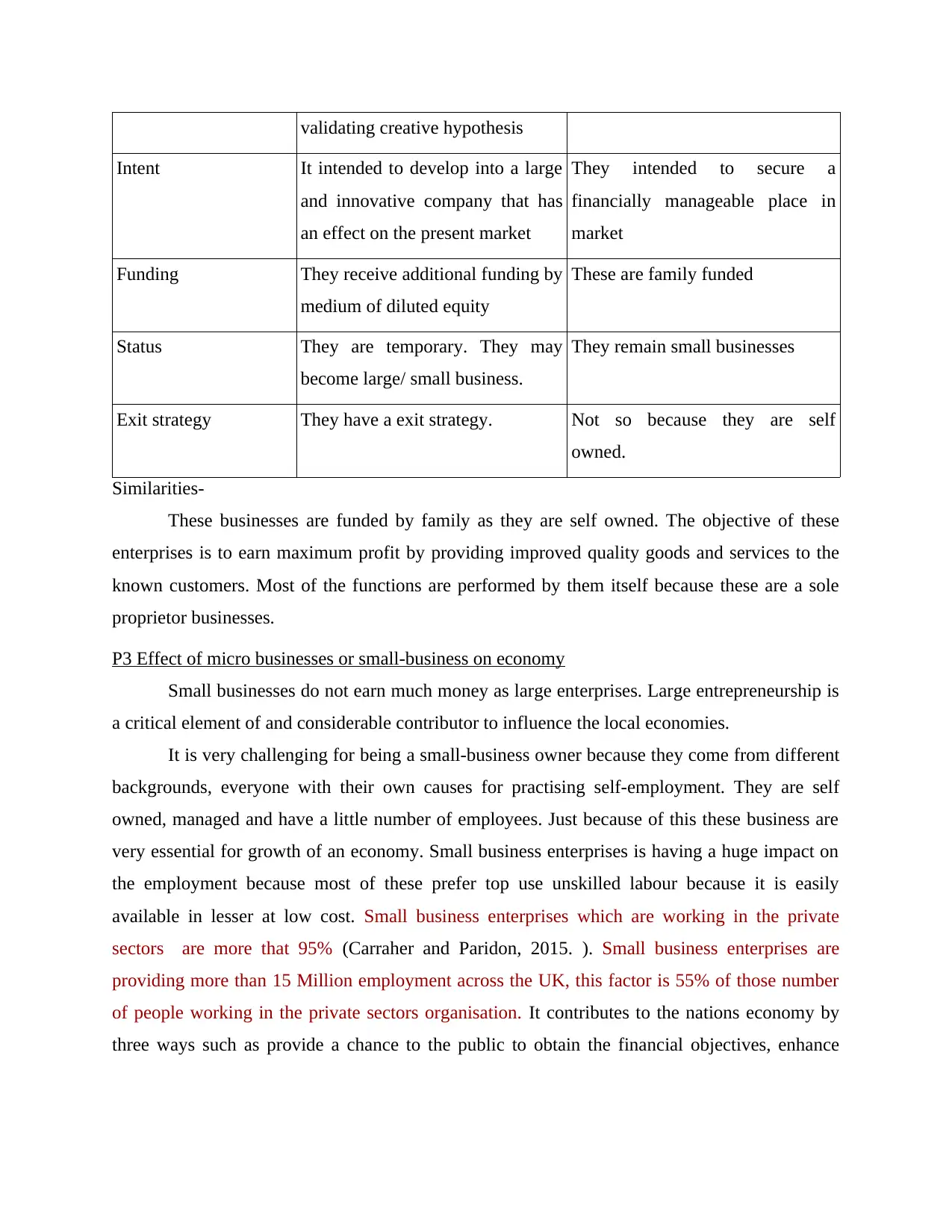
validating creative hypothesis
Intent It intended to develop into a large
and innovative company that has
an effect on the present market
They intended to secure a
financially manageable place in
market
Funding They receive additional funding by
medium of diluted equity
These are family funded
Status They are temporary. They may
become large/ small business.
They remain small businesses
Exit strategy They have a exit strategy. Not so because they are self
owned.
Similarities-
These businesses are funded by family as they are self owned. The objective of these
enterprises is to earn maximum profit by providing improved quality goods and services to the
known customers. Most of the functions are performed by them itself because these are a sole
proprietor businesses.
P3 Effect of micro businesses or small-business on economy
Small businesses do not earn much money as large enterprises. Large entrepreneurship is
a critical element of and considerable contributor to influence the local economies.
It is very challenging for being a small-business owner because they come from different
backgrounds, everyone with their own causes for practising self-employment. They are self
owned, managed and have a little number of employees. Just because of this these business are
very essential for growth of an economy. Small business enterprises is having a huge impact on
the employment because most of these prefer top use unskilled labour because it is easily
available in lesser at low cost. Small business enterprises which are working in the private
sectors are more that 95% (Carraher and Paridon, 2015. ). Small business enterprises are
providing more than 15 Million employment across the UK, this factor is 55% of those number
of people working in the private sectors organisation. It contributes to the nations economy by
three ways such as provide a chance to the public to obtain the financial objectives, enhance
Intent It intended to develop into a large
and innovative company that has
an effect on the present market
They intended to secure a
financially manageable place in
market
Funding They receive additional funding by
medium of diluted equity
These are family funded
Status They are temporary. They may
become large/ small business.
They remain small businesses
Exit strategy They have a exit strategy. Not so because they are self
owned.
Similarities-
These businesses are funded by family as they are self owned. The objective of these
enterprises is to earn maximum profit by providing improved quality goods and services to the
known customers. Most of the functions are performed by them itself because these are a sole
proprietor businesses.
P3 Effect of micro businesses or small-business on economy
Small businesses do not earn much money as large enterprises. Large entrepreneurship is
a critical element of and considerable contributor to influence the local economies.
It is very challenging for being a small-business owner because they come from different
backgrounds, everyone with their own causes for practising self-employment. They are self
owned, managed and have a little number of employees. Just because of this these business are
very essential for growth of an economy. Small business enterprises is having a huge impact on
the employment because most of these prefer top use unskilled labour because it is easily
available in lesser at low cost. Small business enterprises which are working in the private
sectors are more that 95% (Carraher and Paridon, 2015. ). Small business enterprises are
providing more than 15 Million employment across the UK, this factor is 55% of those number
of people working in the private sectors organisation. It contributes to the nations economy by
three ways such as provide a chance to the public to obtain the financial objectives, enhance
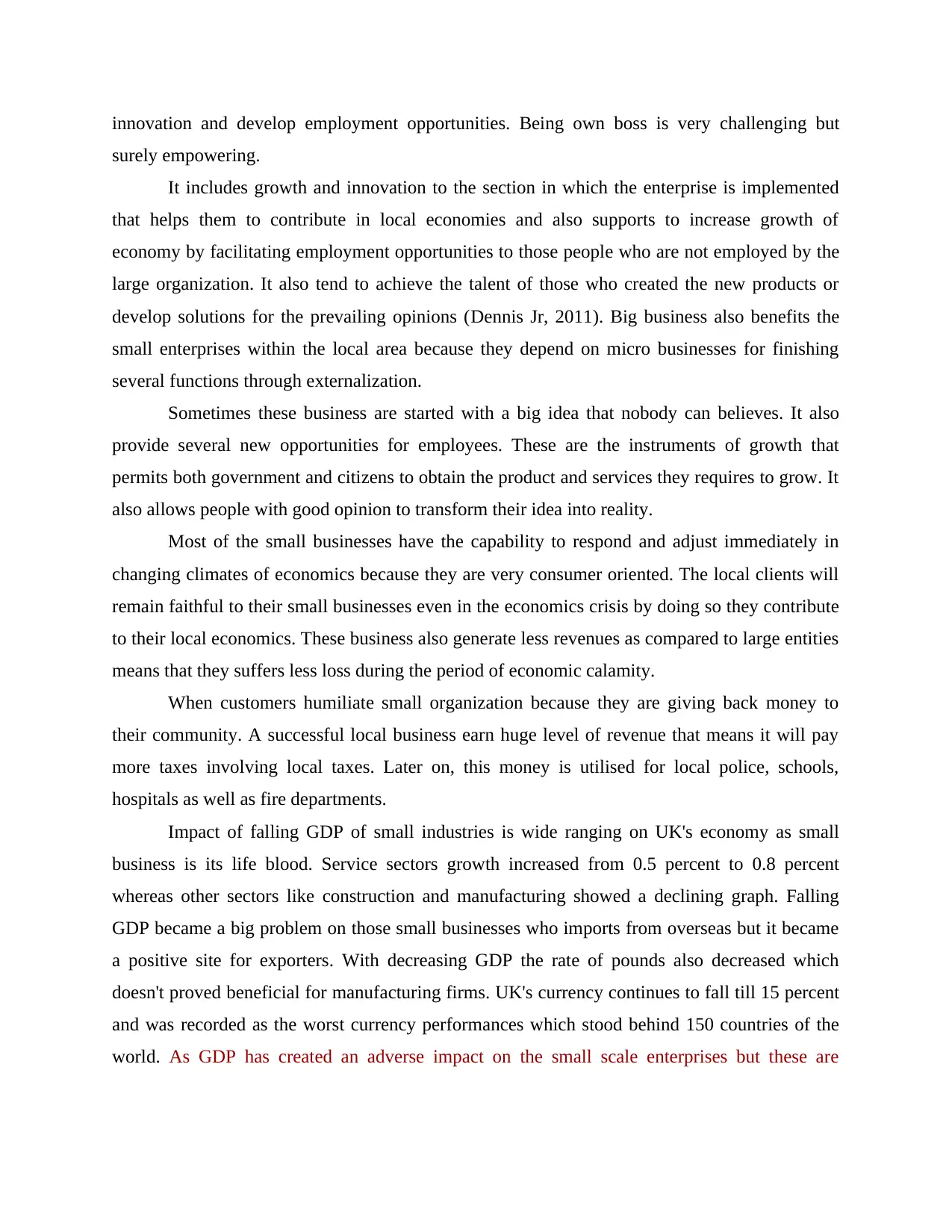
innovation and develop employment opportunities. Being own boss is very challenging but
surely empowering.
It includes growth and innovation to the section in which the enterprise is implemented
that helps them to contribute in local economies and also supports to increase growth of
economy by facilitating employment opportunities to those people who are not employed by the
large organization. It also tend to achieve the talent of those who created the new products or
develop solutions for the prevailing opinions (Dennis Jr, 2011). Big business also benefits the
small enterprises within the local area because they depend on micro businesses for finishing
several functions through externalization.
Sometimes these business are started with a big idea that nobody can believes. It also
provide several new opportunities for employees. These are the instruments of growth that
permits both government and citizens to obtain the product and services they requires to grow. It
also allows people with good opinion to transform their idea into reality.
Most of the small businesses have the capability to respond and adjust immediately in
changing climates of economics because they are very consumer oriented. The local clients will
remain faithful to their small businesses even in the economics crisis by doing so they contribute
to their local economics. These business also generate less revenues as compared to large entities
means that they suffers less loss during the period of economic calamity.
When customers humiliate small organization because they are giving back money to
their community. A successful local business earn huge level of revenue that means it will pay
more taxes involving local taxes. Later on, this money is utilised for local police, schools,
hospitals as well as fire departments.
Impact of falling GDP of small industries is wide ranging on UK's economy as small
business is its life blood. Service sectors growth increased from 0.5 percent to 0.8 percent
whereas other sectors like construction and manufacturing showed a declining graph. Falling
GDP became a big problem on those small businesses who imports from overseas but it became
a positive site for exporters. With decreasing GDP the rate of pounds also decreased which
doesn't proved beneficial for manufacturing firms. UK's currency continues to fall till 15 percent
and was recorded as the worst currency performances which stood behind 150 countries of the
world. As GDP has created an adverse impact on the small scale enterprises but these are
surely empowering.
It includes growth and innovation to the section in which the enterprise is implemented
that helps them to contribute in local economies and also supports to increase growth of
economy by facilitating employment opportunities to those people who are not employed by the
large organization. It also tend to achieve the talent of those who created the new products or
develop solutions for the prevailing opinions (Dennis Jr, 2011). Big business also benefits the
small enterprises within the local area because they depend on micro businesses for finishing
several functions through externalization.
Sometimes these business are started with a big idea that nobody can believes. It also
provide several new opportunities for employees. These are the instruments of growth that
permits both government and citizens to obtain the product and services they requires to grow. It
also allows people with good opinion to transform their idea into reality.
Most of the small businesses have the capability to respond and adjust immediately in
changing climates of economics because they are very consumer oriented. The local clients will
remain faithful to their small businesses even in the economics crisis by doing so they contribute
to their local economics. These business also generate less revenues as compared to large entities
means that they suffers less loss during the period of economic calamity.
When customers humiliate small organization because they are giving back money to
their community. A successful local business earn huge level of revenue that means it will pay
more taxes involving local taxes. Later on, this money is utilised for local police, schools,
hospitals as well as fire departments.
Impact of falling GDP of small industries is wide ranging on UK's economy as small
business is its life blood. Service sectors growth increased from 0.5 percent to 0.8 percent
whereas other sectors like construction and manufacturing showed a declining graph. Falling
GDP became a big problem on those small businesses who imports from overseas but it became
a positive site for exporters. With decreasing GDP the rate of pounds also decreased which
doesn't proved beneficial for manufacturing firms. UK's currency continues to fall till 15 percent
and was recorded as the worst currency performances which stood behind 150 countries of the
world. As GDP has created an adverse impact on the small scale enterprises but these are
⊘ This is a preview!⊘
Do you want full access?
Subscribe today to unlock all pages.

Trusted by 1+ million students worldwide

working better as per expectations from them, in the year of 2016, around £1.8 trillion gross
turnover was tracked by UK government which was made by the small scale sector and this
turnover was 47% of over all gross turnover.
P4 Importance of small businesses in development of social economy
Sustainability is comprises of three factors environmental;, social and economical which
are interrelated with each other. For example, the prevention of natural system needs good social
situations and is unexpected to occur during war. The survival of society requires a encouraging
environment not one demolish by the change in climate (Fassin, Van Rossem and Buelens,
2011). Nothing will happen unless small businesses manage limited resources till disposal
successful in terms of financial and environmental both.
Many small business have their social goals, they do some work that other people in the
society think meaningful and are ready to pay for them. Companies also effect on the
communities specially those that have a remarkable direct effect on the environment like mining,
agriculture and heavy production. It is important for those whoa re living close to their
operations how they are handling them and what degree of care has been taken over effects of
health.
Human rights and initiators relations are also taken into consideration to make sure that
there is no any kind of discrimination in managing, motivating and training their staff (Idogho,
2011). They also adopted a decent work environment.
These all impacts are very easy to recognise than measure. It doesn't mean that any type
of measurement is meaningless. There are a number of significant social effects that are easy to
measure such as tax. The payment of tax is an essential factor which contribute to the social
economy.
The main objective these small businesses is to satisfy the social needs by providing them
better goods and services, employment opportunities and proper utilization of resources which
will lead to achieve the objective of the company and also helps in developing social economy.
The increasing rate of growth of social economy will results in improving the standard of living
of people.
Social economy is collective work of private and public sector for public benefits, most
of the companies which are working in the public sector to provide a better products and services
turnover was tracked by UK government which was made by the small scale sector and this
turnover was 47% of over all gross turnover.
P4 Importance of small businesses in development of social economy
Sustainability is comprises of three factors environmental;, social and economical which
are interrelated with each other. For example, the prevention of natural system needs good social
situations and is unexpected to occur during war. The survival of society requires a encouraging
environment not one demolish by the change in climate (Fassin, Van Rossem and Buelens,
2011). Nothing will happen unless small businesses manage limited resources till disposal
successful in terms of financial and environmental both.
Many small business have their social goals, they do some work that other people in the
society think meaningful and are ready to pay for them. Companies also effect on the
communities specially those that have a remarkable direct effect on the environment like mining,
agriculture and heavy production. It is important for those whoa re living close to their
operations how they are handling them and what degree of care has been taken over effects of
health.
Human rights and initiators relations are also taken into consideration to make sure that
there is no any kind of discrimination in managing, motivating and training their staff (Idogho,
2011). They also adopted a decent work environment.
These all impacts are very easy to recognise than measure. It doesn't mean that any type
of measurement is meaningless. There are a number of significant social effects that are easy to
measure such as tax. The payment of tax is an essential factor which contribute to the social
economy.
The main objective these small businesses is to satisfy the social needs by providing them
better goods and services, employment opportunities and proper utilization of resources which
will lead to achieve the objective of the company and also helps in developing social economy.
The increasing rate of growth of social economy will results in improving the standard of living
of people.
Social economy is collective work of private and public sector for public benefits, most
of the companies which are working in the public sector to provide a better products and services
Paraphrase This Document
Need a fresh take? Get an instant paraphrase of this document with our AI Paraphraser
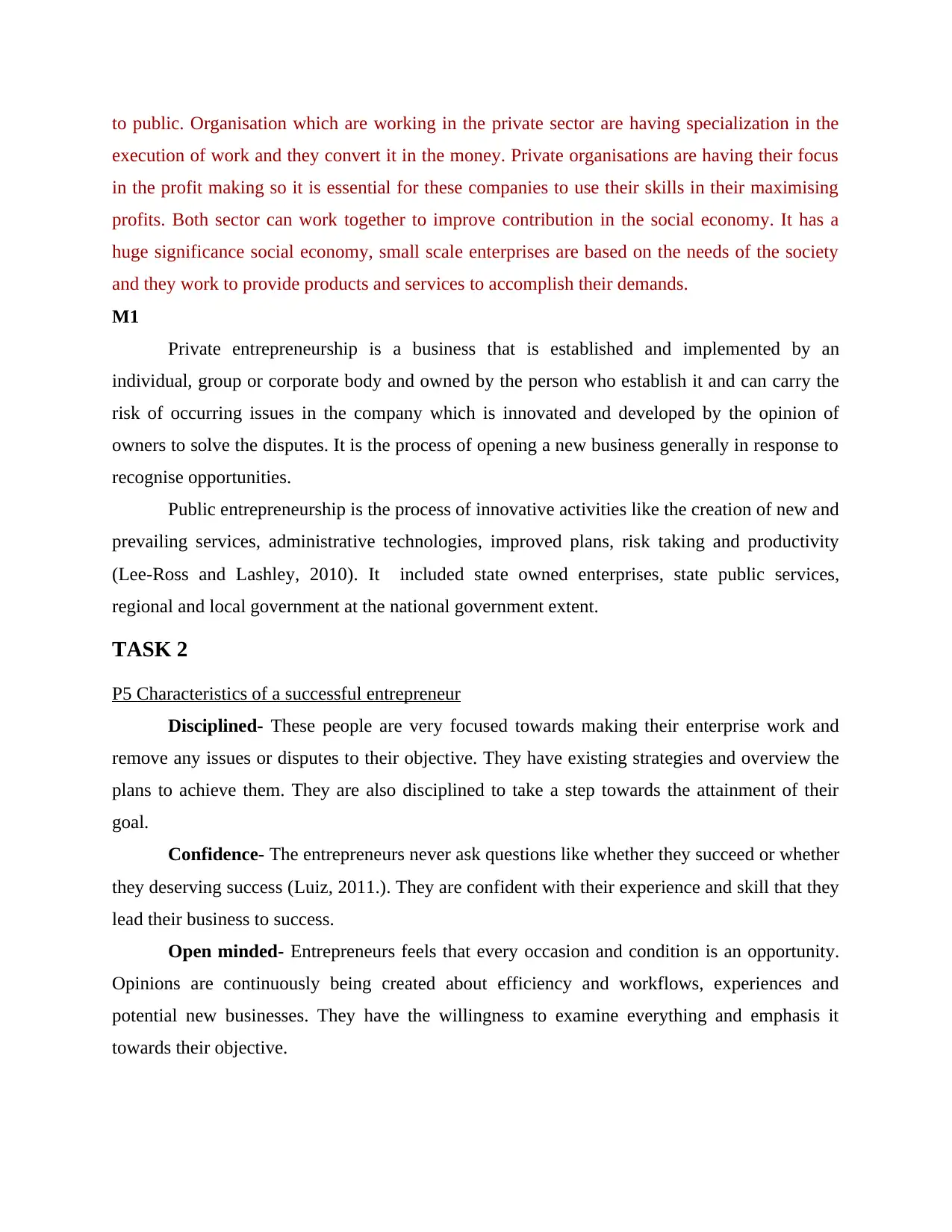
to public. Organisation which are working in the private sector are having specialization in the
execution of work and they convert it in the money. Private organisations are having their focus
in the profit making so it is essential for these companies to use their skills in their maximising
profits. Both sector can work together to improve contribution in the social economy. It has a
huge significance social economy, small scale enterprises are based on the needs of the society
and they work to provide products and services to accomplish their demands.
M1
Private entrepreneurship is a business that is established and implemented by an
individual, group or corporate body and owned by the person who establish it and can carry the
risk of occurring issues in the company which is innovated and developed by the opinion of
owners to solve the disputes. It is the process of opening a new business generally in response to
recognise opportunities.
Public entrepreneurship is the process of innovative activities like the creation of new and
prevailing services, administrative technologies, improved plans, risk taking and productivity
(Lee-Ross and Lashley, 2010). It included state owned enterprises, state public services,
regional and local government at the national government extent.
TASK 2
P5 Characteristics of a successful entrepreneur
Disciplined- These people are very focused towards making their enterprise work and
remove any issues or disputes to their objective. They have existing strategies and overview the
plans to achieve them. They are also disciplined to take a step towards the attainment of their
goal.
Confidence- The entrepreneurs never ask questions like whether they succeed or whether
they deserving success (Luiz, 2011.). They are confident with their experience and skill that they
lead their business to success.
Open minded- Entrepreneurs feels that every occasion and condition is an opportunity.
Opinions are continuously being created about efficiency and workflows, experiences and
potential new businesses. They have the willingness to examine everything and emphasis it
towards their objective.
execution of work and they convert it in the money. Private organisations are having their focus
in the profit making so it is essential for these companies to use their skills in their maximising
profits. Both sector can work together to improve contribution in the social economy. It has a
huge significance social economy, small scale enterprises are based on the needs of the society
and they work to provide products and services to accomplish their demands.
M1
Private entrepreneurship is a business that is established and implemented by an
individual, group or corporate body and owned by the person who establish it and can carry the
risk of occurring issues in the company which is innovated and developed by the opinion of
owners to solve the disputes. It is the process of opening a new business generally in response to
recognise opportunities.
Public entrepreneurship is the process of innovative activities like the creation of new and
prevailing services, administrative technologies, improved plans, risk taking and productivity
(Lee-Ross and Lashley, 2010). It included state owned enterprises, state public services,
regional and local government at the national government extent.
TASK 2
P5 Characteristics of a successful entrepreneur
Disciplined- These people are very focused towards making their enterprise work and
remove any issues or disputes to their objective. They have existing strategies and overview the
plans to achieve them. They are also disciplined to take a step towards the attainment of their
goal.
Confidence- The entrepreneurs never ask questions like whether they succeed or whether
they deserving success (Luiz, 2011.). They are confident with their experience and skill that they
lead their business to success.
Open minded- Entrepreneurs feels that every occasion and condition is an opportunity.
Opinions are continuously being created about efficiency and workflows, experiences and
potential new businesses. They have the willingness to examine everything and emphasis it
towards their objective.
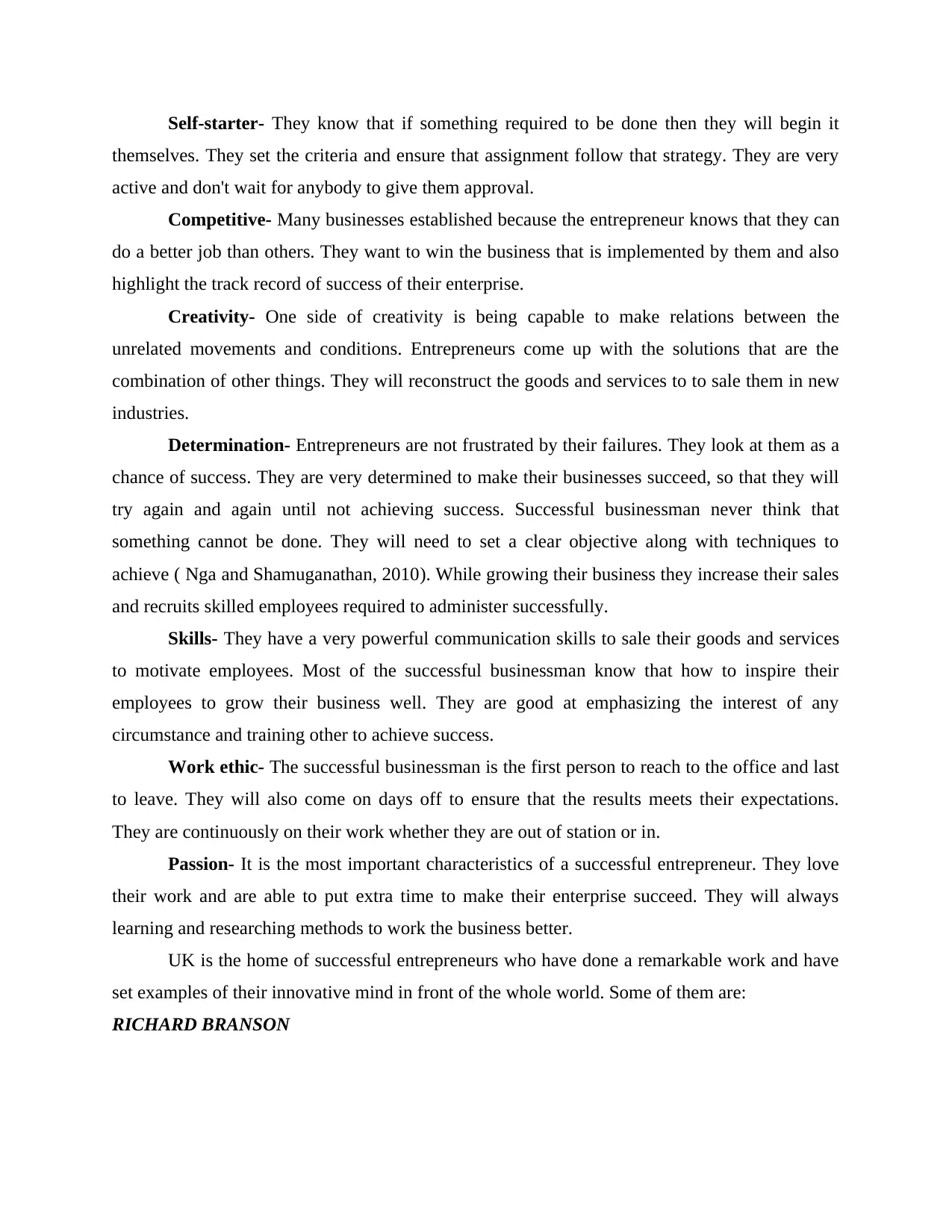
Self-starter- They know that if something required to be done then they will begin it
themselves. They set the criteria and ensure that assignment follow that strategy. They are very
active and don't wait for anybody to give them approval.
Competitive- Many businesses established because the entrepreneur knows that they can
do a better job than others. They want to win the business that is implemented by them and also
highlight the track record of success of their enterprise.
Creativity- One side of creativity is being capable to make relations between the
unrelated movements and conditions. Entrepreneurs come up with the solutions that are the
combination of other things. They will reconstruct the goods and services to to sale them in new
industries.
Determination- Entrepreneurs are not frustrated by their failures. They look at them as a
chance of success. They are very determined to make their businesses succeed, so that they will
try again and again until not achieving success. Successful businessman never think that
something cannot be done. They will need to set a clear objective along with techniques to
achieve ( Nga and Shamuganathan, 2010). While growing their business they increase their sales
and recruits skilled employees required to administer successfully.
Skills- They have a very powerful communication skills to sale their goods and services
to motivate employees. Most of the successful businessman know that how to inspire their
employees to grow their business well. They are good at emphasizing the interest of any
circumstance and training other to achieve success.
Work ethic- The successful businessman is the first person to reach to the office and last
to leave. They will also come on days off to ensure that the results meets their expectations.
They are continuously on their work whether they are out of station or in.
Passion- It is the most important characteristics of a successful entrepreneur. They love
their work and are able to put extra time to make their enterprise succeed. They will always
learning and researching methods to work the business better.
UK is the home of successful entrepreneurs who have done a remarkable work and have
set examples of their innovative mind in front of the whole world. Some of them are:
RICHARD BRANSON
themselves. They set the criteria and ensure that assignment follow that strategy. They are very
active and don't wait for anybody to give them approval.
Competitive- Many businesses established because the entrepreneur knows that they can
do a better job than others. They want to win the business that is implemented by them and also
highlight the track record of success of their enterprise.
Creativity- One side of creativity is being capable to make relations between the
unrelated movements and conditions. Entrepreneurs come up with the solutions that are the
combination of other things. They will reconstruct the goods and services to to sale them in new
industries.
Determination- Entrepreneurs are not frustrated by their failures. They look at them as a
chance of success. They are very determined to make their businesses succeed, so that they will
try again and again until not achieving success. Successful businessman never think that
something cannot be done. They will need to set a clear objective along with techniques to
achieve ( Nga and Shamuganathan, 2010). While growing their business they increase their sales
and recruits skilled employees required to administer successfully.
Skills- They have a very powerful communication skills to sale their goods and services
to motivate employees. Most of the successful businessman know that how to inspire their
employees to grow their business well. They are good at emphasizing the interest of any
circumstance and training other to achieve success.
Work ethic- The successful businessman is the first person to reach to the office and last
to leave. They will also come on days off to ensure that the results meets their expectations.
They are continuously on their work whether they are out of station or in.
Passion- It is the most important characteristics of a successful entrepreneur. They love
their work and are able to put extra time to make their enterprise succeed. They will always
learning and researching methods to work the business better.
UK is the home of successful entrepreneurs who have done a remarkable work and have
set examples of their innovative mind in front of the whole world. Some of them are:
RICHARD BRANSON
⊘ This is a preview!⊘
Do you want full access?
Subscribe today to unlock all pages.

Trusted by 1+ million students worldwide
1 out of 17
Related Documents
Your All-in-One AI-Powered Toolkit for Academic Success.
+13062052269
info@desklib.com
Available 24*7 on WhatsApp / Email
![[object Object]](/_next/static/media/star-bottom.7253800d.svg)
Unlock your academic potential
Copyright © 2020–2025 A2Z Services. All Rights Reserved. Developed and managed by ZUCOL.




